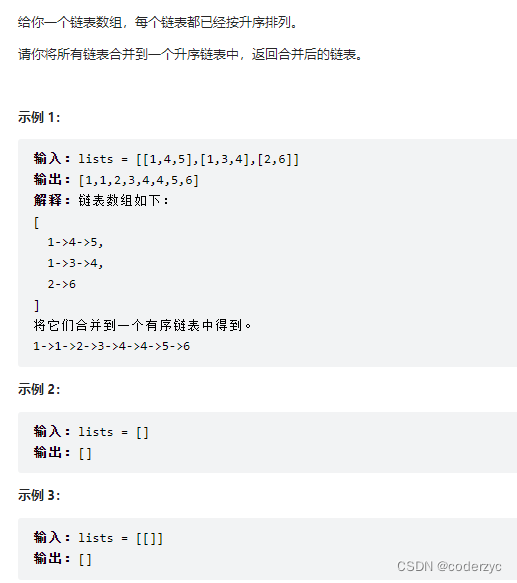-
23 合并K个升序链表
leetcode 23 合并K个升序链表

分治归并思路
思路类似于数组的归并排序,两两组合,每次由两个链表合并
/** * Definition for singly-linked list. * public class ListNode { * int val; * ListNode next; * ListNode() {} * ListNode(int val) { this.val = val; } * ListNode(int val, ListNode next) { this.val = val; this.next = next; } * } */ class Solution { public ListNode mergeKLists(ListNode[] lists) { return merge(lists,0,lists.length-1); } public ListNode merge(ListNode[] lists,int L,int R){ if(L>R){ return null; } if(L==R){ return lists[L]; } // int mid = R-(R-L)/2; int mid = (L + R) >> 1; return mergeTwoList(merge(lists,L,mid),merge(lists,mid+1,R)); } public ListNode mergeTwoList(ListNode list1,ListNode list2){ if(list1==null | list2==null){ return list1==null?list2 : list1; } ListNode head = new ListNode(0); ListNode tail = head; ListNode aPtr = list1; ListNode bPtr = list2; while(aPtr != null && bPtr != null){ if(aPtr.val < bPtr.val){ tail.next = aPtr; aPtr = aPtr.next; }else{ tail.next = bPtr; bPtr = bPtr.next; } tail = tail.next; } tail.next = aPtr != null? aPtr : bPtr; return head.next; } }- 1
- 2
- 3
- 4
- 5
- 6
- 7
- 8
- 9
- 10
- 11
- 12
- 13
- 14
- 15
- 16
- 17
- 18
- 19
- 20
- 21
- 22
- 23
- 24
- 25
- 26
- 27
- 28
- 29
- 30
- 31
- 32
- 33
- 34
- 35
- 36
- 37
- 38
- 39
- 40
- 41
- 42
- 43
- 44
- 45
- 46
- 47
优先队列思路
优先队列中存n个队列的头部,让优先队列来进行排序,降低复杂度(注意:需要重写优先队列的Compare逻辑)
/** * Definition for singly-linked list. * public class ListNode { * int val; * ListNode next; * ListNode() {} * ListNode(int val) { this.val = val; } * ListNode(int val, ListNode next) { this.val = val; this.next = next; } * } */ class Solution { class Comp implements Comparable<Comp> { Comp(ListNode node,int val){ this.node = node; this.val = val; } ListNode node; int val; public int compareTo(Comp comp2){ return this.val - comp2.val; } } public ListNode mergeKLists(ListNode[] lists) { PriorityQueue<Comp> queue = new PriorityQueue<Comp>(); for(int i = 0;i<lists.length;i++){ if(lists[i] != null){ queue.offer(new Comp(lists[i],lists[i].val)); } } ListNode head = new ListNode(0); ListNode tail = head; while(!queue.isEmpty()){ Comp c = queue.poll(); tail.next = c.node; tail = tail.next; if(c.node.next != null){ queue.offer(new Comp(c.node.next,c.node.next.val)); } } return head.next; } }- 1
- 2
- 3
- 4
- 5
- 6
- 7
- 8
- 9
- 10
- 11
- 12
- 13
- 14
- 15
- 16
- 17
- 18
- 19
- 20
- 21
- 22
- 23
- 24
- 25
- 26
- 27
- 28
- 29
- 30
- 31
- 32
- 33
- 34
- 35
- 36
- 37
- 38
- 39
- 40
- 41
- 42
-
相关阅读:
Android实现在activity启动时传递对象和字符串参数
8位机adc采样正弦波频率
(八)Linux搭载4G模块——PDU短信格式的获取与解码
Python基础知识:运算符详解
深度学习 paper 代码复现参考
力扣1726. 同积元组
【MySQL入门指北】MySQL 彻底删除
golang优化命令执行
案例分析真题--架构师
2022杭电多校3——补题
- 原文地址:https://blog.csdn.net/qq_44686225/article/details/127804124
